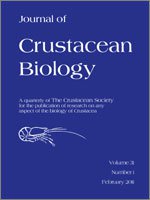Burrow architecture of the ghost crab, Ocypode ceratophthalmus was studied at Sai Kaew beach (a pristine sandy habitat) in southern Thailand. The burrows of 131 individuals were cast with molten wax and carefully excavated. Only complete burrow casts with crab-occupant (n = 67) were used in the data analyses. Burrows were grouped into categories according to their shapes: J, U or Y-burrows; and further classified into those excavated by juvenile and young adult crabs based on carapace width: juvenile, Juv, (CW < 20 mm; n = 53) and young adults, YgA (CW ≥ 20 mm; n = 14). All J, U and Y-burrows have an ascending arm that opens on the surface of the substrate ( = Open Arm, OA). The other ascending arm of U and Y-burrows terminates a short distance from the surface of the shore ( = Blind-ending Arm, BeA). Y-burrows were predominant (66%) as compared to J and U-burrows (13% and 21% respectively). Juvenile Y-burrows had a steeper angle of descent of the OA which may provide better protection from predators through rapid retreat to deeper depths. Smaller βJuv (cf. αJuv) indicates a gentler gradient that may facilitate escape. βJuv is also not significantly different from βYgA suggesting an optimal gradient for crabs to push through the last cm or so of sand above the BeA to escape from predators. The larger θ in YgA burrows could improve maneuverability down the shaft as YgA have larger body volumes than Juv. αJuv and αYgA of J, U and Y-burrows and β of U and Y-burrows were not significantly different. The arm depths of juvenile J, U and Y-burrows were also similar. Comparison of the relationship between arm depth and shaft depth against the total depth in Juv and YgA Y-burrows indicates that the deepening of Y-burrows occurs mainly by the lengthening of the shafts. Results from this study provide evidence that the J and U-shaped burrows could be the precursors of Y-shaped burrows in the excavation process.
How to translate text using browser tools
1 February 2011
Comparison of Burrow Morphology of Juvenile and Young Adult Ocypode ceratophthalmus from Sai Kaew, Thailand
Shirley S. L. Lim,
Adeline Y. P. Yong,
Pitiwong Tantichodok
ACCESS THE FULL ARTICLE
It is not available for individual sale.
This article is only available to subscribers.
It is not available for individual sale.
It is not available for individual sale.

Journal of Crustacean Biology
Vol. 31 • No. 1
February 2011
Vol. 31 • No. 1
February 2011
burrow morphology
Ocypode ceratophthalmus




